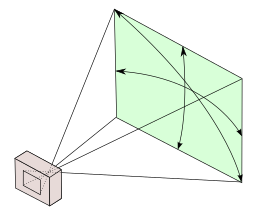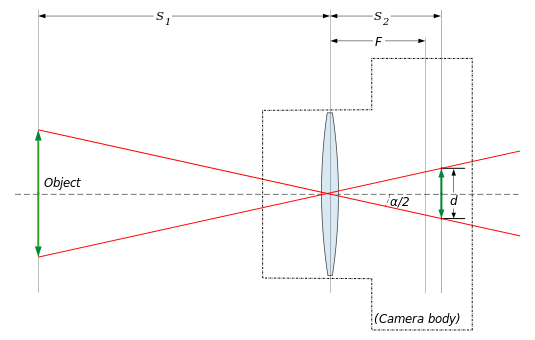దృష్టి కోణం: కూర్పుల మధ్య తేడాలు
చి యంత్రము కలుపుతున్నది: it:Angolo di campo |
చి : id:Sudut pandang |
||
| పంక్తి 152: | పంక్తి 152: | ||
[[de:Bildwinkel]] |
[[de:Bildwinkel]] |
||
[[es:Ángulo de visión]] |
[[es:Ángulo de visión]] |
||
[[id:Sudut pandang]] |
|||
[[it:Angolo di campo]] |
[[it:Angolo di campo]] |
||
[[ja:画角]] |
[[ja:画角]] |
||
01:42, 4 నవంబరు 2009 నాటి కూర్పు
ఈ వ్యాసాన్ని పూర్తిగా అనువదించి, తరువాత ఈ మూసను తీసివేయండి. అనువాదం చేయాల్సిన వ్యాస భాగం ఒకవేళ ప్రధాన పేరుబరిలో వున్నట్లయితే పాఠ్యం సవరించు నొక్కినప్పుడు కనబడవచ్చు. అనువాదం పూర్తయినంతవరకు ఎర్రలింకులు లేకుండా చూడాలంటే ప్రస్తుత ఆంగ్ల కూర్పుని, భాషల లింకుల ద్వారా చూడండి(అనువాదకులకు వనరులు) |
దృష్టి కోణం(Angle of view)

In photography, angle of view describes the angular extent of a given scene that is imaged by a camera. It parallels, and may be used interchangeably with, the more general visual term field of view.
It is important to distinguish the angle of view from the angle of coverage, which describes the angle of projection by the lens onto the focal plane. For most cameras, it may be assumed that the image circle produced by the lens is large enough to cover the film or sensor completely.[1] If the angle of view exceeds the angle of coverage, however, then vignetting will be present in the resulting photograph. For an example of this, see below.
కెమెరా దృష్టికోణాన్ని లెక్కకట్టడం
For lenses projecting rectilinear (non-spatially-distorted) images of distant objects, the effective focal length and the image format dimensions completely define the angle of view. Calculations for lenses producing non-rectilinear images are much more complex and in the end not very useful in most practical applications.
Angle of view may be measured horizontally (from the left to right edge of the frame), vertically (from the top to bottom of the frame), or diagonally (from one corner of the frame to its opposite corner).
For a lens projecting a rectilinear image, the angle of view (α) can be calculated from the chosen dimension (d), and effective focal length (f) as follows:[3]
Because this is a trigonometric function, the angle of view does not vary quite linearly with the reciprocal of the focal length. However, except for wide-angle lenses, it is reasonable to approximate radians or degrees.
The effective focal length is nearly equal to the stated focal length of the lens (F), except in macro photography where the lens-to-object distance is comparable to the focal length. In this case, the magnification factor (m) must be taken into account:
(In photography is usually defined to be positive, despite the inverted image.) For example, with a magnification ratio of 1:2, we find and thus the angle of view is reduced by 33% compared to focusing on a distant object with the same lens.
ఉదాహరణ
Consider a 35 mm camera with a normal lens having a focal length of F=50 mm. The dimensions of the 35 mm image format are 24 mm (vertically) × 36 mm (horizontal), giving a diagonal of about 43.3 mm.
Now the angles of view are:
- horizontally, 39.6°
- vertically, 27.0°
- diagonally, 46.7°
Derivation of the angle-of-view formula
Consider a lens in a camera being used to photograph an object at a distance , and forming an image that just barely fits in the dimension of the frame (the film or image sensor); treat the lens as if it were a pinhole at distance from the image plane:

Now is the angle between the optical axis of the lens and the ray joining its optical center to the edge of the film. Here is defined to be the angle-of-view, since it is the angle enclosing the largest object whose image can fit on the film. We want to find the relationship between:
- the angle (half of the angle-of-view)
- the "opposite" side of the right triangle, (half the film-format dimension)
- the "adjacent" side, (distance from the lens to the image plane)
Using basic trigonometry, we find:
which we can solve for α, giving:
To project a sharp image of distant objects, needs to be equal to the focal length , which is attained by setting the lens for infinity focus. Then the angle of view is given by:
- where
సూక్ష్మ(మాక్రో)ఫోటోగ్రఫి
For macro photography, we cannot neglect the difference between and From the thin lens formula,
- .
We substitute for the magnification, , and with some algebra find:
Defining as the "effective focal length", we get the formula presented above:
- where .
కాటకాల రకాలు వాటి ప్రభావం
Lenses are often referred to by terms that express their angle of view:
- Ultra wide-angle lenses, also known as fisheye lenses, cover up to 180° (or even wider in special cases)
- Wide-angle lenses generally cover between 100° and 60°
- Normal, or Standard lenses generally cover between 50° and 25°
- Telephoto lenses generally cover between 15° and 10°
- Super Telephoto lenses generally cover between 8° through less than 1°
Zoom lenses are a special case wherein the focal length, and hence angle of view, of the lens can be altered mechanically without removing the lens from the camera.
Longer lenses magnify the subject more, apparently compressing distance and (when focused on the foreground) blurring the background because of their shallower depth of field. Wider lenses tend to magnify distance between objects while allowing greater depth of field.
Another result of using a wide angle lens is a greater apparent perspective distortion when the camera is not aligned perpendicularly to the subject: parallel lines converge at the same rate as with a normal lens, but converge more due to the wider total field. For example, buildings appear to be falling backwards much more severely when the camera is pointed upward from ground level than they would if photographed with a normal lens at the same distance from the subject, because more of the subject building is visible in the wide-angle shot.
Because different lenses generally require a different camera–subject distance to preserve the size of a subject, changing the angle of view can indirectly distort perspective, changing the apparent relative size of the subject and foreground.
 |
 |
 |
 |
గుండ్రటి చేపకన్ను దృష్టి కోణం(circular fisheye)
A circular fisheye lens (as opposed to a full-frame fisheye) is an example of a lens where the angle of coverage is less than the angle of view. The image projected onto the film is circular because the diameter of the image projected is narrower than that needed to cover the widest portion of the film.
సాదారణ కటక దృష్టి కోణం
This table shows the diagonal, horizontal, and vertical angles of view, in degrees, for lenses producing rectilinear images, when used with 36 mm × 24 mm format (that is, 135 film or full-frame 35mm digital using width 36 mm, height 24 mm, and diagonal 43.3 mm for d in the formula above[4]).
| Focal Length (mm) | 13 | 15 | 18 | 21 | 24 | 28 | 35 | 50 | 85 | 105 | 135 | 180 | 210 | 300 | 400 | 500 | 600 | 830 | 1200 |
|---|---|---|---|---|---|---|---|---|---|---|---|---|---|---|---|---|---|---|---|
| Diagonal (°) | 118 | 111 | 100 | 91.7 | 84.1 | 75.4 | 63.4 | 46.8 | 28.6 | 23.3 | 18.2 | 13.7 | 11.8 | 8.25 | 6.19 | 4.96 | 4.13 | 2.99 | 2.07 |
| Vertical (°) | 85.4 | 77.3 | 67.4 | 59.5 | 53.1 | 46.4 | 37.8 | 27.0 | 16.1 | 13.0 | 10.2 | 7.63 | 6.54 | 4.58 | 3.44 | 2.75 | 2.29 | 1.66 | 1.15 |
| Horizontal (°) | 108 | 100.4 | 90.0 | 81.2 | 73.7 | 65.5 | 54.4 | 39.6 | 23.9 | 19.5 | 15.2 | 11.4 | 9.80 | 6.87 | 5.15 | 4.12 | 3.44 | 2.48 | 1.72 |
Three-dimensional digital art
Displaying 3d graphics requires 3d projection of the models onto a 2d surface, and uses a series of mathematical calculations to render the scene. The angle of view of the scene is thus readily set and changed; some renderers even measure the angle of view as the focal length of an imaginary lens. The angle of view can also be projected onto the surface at an angle greater than 90°, effectively creating a fish eye lens effect.
సినిమాటోగ్రఫి
Modifying the angle of view over time, or zooming, is a frequently used cinematic technique.
Video games
As an effect, some first person games, especially racing games, widen the angle of view beyond 90° to exaggerate the distance the player is travelling, thus exaggerating the player's perceived speed. This effect can be done progressively, or upon the activation of some sort of "turbo boost." An interesting visual effect in itself, it also provides a way for game developers to suggest speeds faster than the game engine or computer hardware is capable of displaying. Some examples include Burnout 3: Takedown and Grand Theft Auto: San Andreas.
Players of first-person shooter games sometimes set the angle of view of the game, widening it in an unnatural way (a difference of 20 or 30 degrees from normal), in order to see more peripherally.
References and notes
- ↑ One exception is technical photography involving view camera movements, in which the optical axis of the lens may not be aligned with the center of the frame. The photographer must ensure that the angle of coverage of the lens is large enough to cover the frame in this case.
- ↑ Neil Wayne Northey (Sept. 1916). Frank V. Chambers (ed.). "The Angle of View of your Lens". The Camera. 20 (9). Columbia Photographic Society.
{{cite journal}}: Check date values in:|date=(help) - ↑ Ernest McCollough (1893). "Photographic Topography". Industry: A Monthly Magazine Devoted to Science, Engineering and Mechanic Arts. Industrial Publishing Company, San Francisco: 399–406.
- ↑ However, most interchangeable-lens digital cameras do not use 24x36 mm image sensors and therefore produce narrower angles of view than set out in the table. See crop factor and the subtopic digital camera issues in the article on wide-angle lenses for further discussion.






















